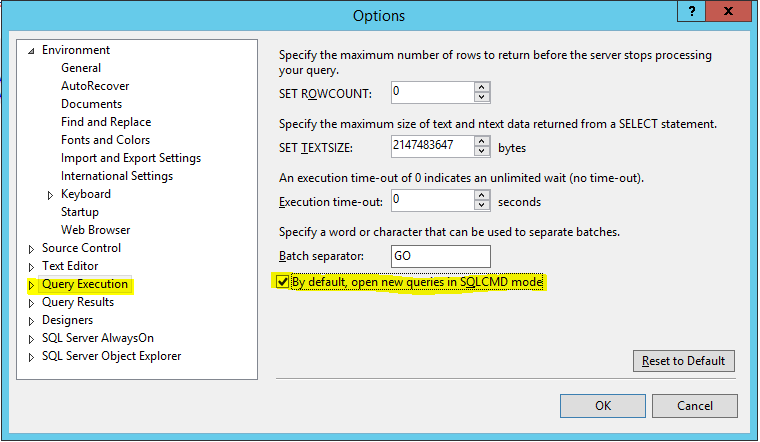|
1 2 3 4 5 6 7 8 9 10 11 12 13 14 15 16 17 18 19 20 21 22 23 24 25 26 27 28 29 30 31 32 33 34 35 36 37 38 39 40 41 42 43 44 45 46 47 48 49 50 51 52 53 54 55 56 57 58 59 60 61 62 63 64 65 66 67 68 69 70 71 72 73 74 75 76 77 78 79 80 81 82 83 84 85 86 87 88 89 90 91 92 93 94 95 96 97 98 99 100 101 102 103 104 105 106 107 108 109 110 111 112 113 114 115 116 117 118 119 120 121 122 123 124 125 126 127 128 129 130 131 132 133 134 135 136 137 138 139 140 141 142 143 144 145 146 147 148 149 150 151 152 153 154 155 156 157 158 159 |
/* RUN THIS SCRIPT FROM THE *TARGET* DATABASE Copies table data from the @sourceDb database to the target database. Only tables that *do not* have segment code columns are copied. Optionally deletes the target table data if @deleteTargetData is set to 1 */ use [MyTargetDatabaseHere]; declare @sourceDb nvarchar(255) = 'MySourceDatabaseHere'; declare @deleteTargetData bit = 1; declare @message nvarchar(max) = null; begin try --disable triggers and constraints for target db exec sp_MSforeachtable 'alter table ? disable trigger all; alter table ? nocheck constraint all;' --create results temp table if (object_id('tempdb..#Results') is not null) drop table #Results create table #Results ([Name] nvarchar(1000), [Success] bit, [Error] nvarchar(max)); --create #Table that contains the schema, table and column names of all tables in the database if (object_id('tempdb..#Tables') is not null) drop table #Tables select [Table] ,[Schema] ,[Columns] = left([Columns],len(columns)-1) ,[HasCodes] = convert(bit,case when charindex('sCodeID',[Columns], 1) > 0 then 1 else 0 end) ,[HasIdentity] = [Identity].[HasIdentity] into #Tables from ( select top 10000 [Table] = t.name ,[TableObjectId] = t.object_id ,[Schema] = s.[Name] ,[Columns] = substring( ( select '[' + c.name + '], ' from sys.columns c where t.object_id = c.object_id order by c.[Name] for xml path('') ) ,1,8000) from sys.tables t join sys.schemas s on t.[schema_id]= s.[schema_id] where t.type = 'U' order by t.name ) as f1 outer apply(select top 1 [HasIdentity] = [is_identity] from sys.columns where object_id = f1.[TableObjectId]) as [Identity] where f1.[Table] not like 'sys%' group by [Table],[Schema],[Columns],[HasIdentity] order by [Schema],[Table] --create #NoCodeTables from #Table that contains only those tables that do not contain segment code columns if (object_id('tempdb..#NoCodeTables') is not null) drop table #NoCodeTables select * into #NoCodeTables from #Tables where [HasCodes] = 0 select * from #NoCodeTables declare @table nvarchar(255) declare @schema nvarchar(255) declare @schemaAndTable nvarchar(1000) declare @columns nvarchar(max) declare @hasIdentity bit declare @sql nvarchar(max) --iterate the #NoCodeTables rows and do the copying while(1=1) begin set @table = null; set @sql = null; set @message = null; --get a row to process from #NoCodeTables select top 1 @table = [Table] ,@schema = [Schema] ,@columns = [Columns] ,@hasIdentity = [HasIdentity] ,@schemaAndTable = '[' + @schema + '].[' + @table + ']' --combine schema and table names here for convenience from #NoCodeTables order by [Table],[Schema] if(@table is not null) begin begin try --optionally delete the target table data if(@deleteTargetData = 1) begin --if a truncate doesn't work then fall back to a delete set @message = @schemaAndTable + ' emptying...' raiserror (@message, 0, 1) with nowait --print immediately set @sql = 'begin try truncate table ' + @schemaAndTable + '; end try begin catch delete ' + @schemaAndTable + '; end catch'; exec (@sql); end --copy from source to target table set @message = @schemaAndTable + ' copying...' raiserror (@message, 0, 1) with nowait --print immediately --some tables have identity columns, if so, set to allow copying first set @sql = case when @hasIdentity = 1 then 'SET IDENTITY_INSERT [' + @table + '] ON;' else '' end + 'insert ' + @schemaAndTable + ' (' + @columns + ') select ' + @columns + ' from [' + @sourceDb + '].' + @schemaAndTable + ';' + case when @hasIdentity = 1 then 'SET IDENTITY_INSERT [' + @table + '] OFF;' else '' end --print @sql exec(@sql); --success! set messages set @message = @schemaAndTable + ' done.' insert #Results ([Name],[Success]) values (@schemaAndTable, 1) --insert raiserror (@message, 0, 1) with nowait --print immediately end try begin catch --fail. set message set @message = @schemaAndTable + ' copy FAILED.' + error_message() insert #Results ([Name],[Success],[Error]) values (@schemaAndTable, 0, @message) raiserror (@message, 0, 1) with nowait --print immediately end catch --delete the completed row from #NoCodeTables in preparation to move on to the next one delete from #NoCodeTables where [Table] = @table end else break; --all #NoCodeTables rows have been processed, break out of the loop end --display results select * from #Results order by [Name] end try begin catch --error of some kind, print it and re-enable triggers and constraints (which may fail if a partial copy situation) set @message = error_message() raiserror (@message, 0, 1) with nowait --print immediately --enable triggers and constraints for target db exec sp_MSforeachtable 'alter table ? enable trigger all; alter table ? check constraint all;' end catch |

